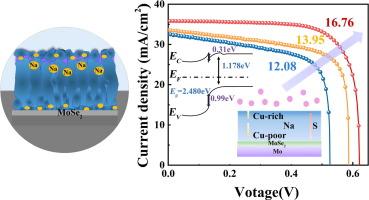通过原位掺杂 Na 提高硫化后 CIGS 太阳能电池的效率
IF 13.1
1区 化学
Q1 Energy
引用次数: 0
摘要
尽管在制备 Cu(In,Ga)Se2 (CIGS) 吸收体时,硫化具有改善光电性能的优势,但吸收体中的深层次缺陷和前表面能级排列不良仍然是限制硫化 CIGS 太阳能电池功率转换效率 (PCE) 提高的主要障碍。本文提出了一种原位 Na 掺杂策略,即利用晶体生长的拖尾效应促进 CIGS 吸收体的硫化。研究发现,由于上表面附近 NaSex 的富集,Na 的掺入支持了晶粒的生长。晶粒生长过程中高溶解度的 Na 不仅能抑制吸收体中固有的 InCu 供体缺陷,还能定制 S 在体中的分布和异质结的带排列,这都有利于有效电子载流子的产生。同时,吸收体底部附近的 Na 聚集也有助于晶体质量的提高和背面接触处超薄 MoSe2 的形成,从而降低了有利于空穴传输的势垒高度。冠军器件的 PCE 高达 16.76%,提高了 28%。这项研究为合成 CIGS 太阳能电池和其他钙钛矿太阳能电池提供了新的视角,使其在使用强硫化工艺时具有更优越的电池性能。本文章由计算机程序翻译,如有差异,请以英文原文为准。

Efficiency improvement for post-sulfurized CIGS solar cells enabled by in situ Na doping
Despite sulfurization offers the advantage of improving the photovoltaic performance in preparing Cu(In,Ga)Se2 (CIGS) absorbers, deep level defects in the absorber and poor energy level alignment on the front surface are still main obstacles limiting the improvement of power conversion efficiency (PCE) in sulfided CIGS solar cells. Herein, an in-situ Na doping strategy is proposed, in which the tailing effect of crystal growth is used to promote the sulfurization of CIGS absorbers. It is found that the grain growth is supported by Na incorporating due to the enrichment of NaSex near the upper surface. The high soluble Na during grain growth can not only suppress intrinsic InCu donor defects in the absorber, but also tailor S distribution in bulk and the band alignment at the heterojunction, which are both beneficial for the effective electron carriers. Meanwhile, the Na aggregation near the bottom of the absorber also contributes to the crystalline quality increasing and favorable ultra-thin MoSe2 formation at back contact, resulting in a reduced barrier height conducive to hole transport. PCE of the champion device is as high as 16.76% with a 28% increase. This research offers new insights into synthesizing CIGS solar cells and other chalcogenide solar cells with superior cell performance when using an intense sulfurization process.
求助全文
通过发布文献求助,成功后即可免费获取论文全文。
去求助
来源期刊

Journal of Energy Chemistry
CHEMISTRY, APPLIED-CHEMISTRY, PHYSICAL
CiteScore
19.10
自引率
8.40%
发文量
3631
审稿时长
15 days
期刊介绍:
The Journal of Energy Chemistry, the official publication of Science Press and the Dalian Institute of Chemical Physics, Chinese Academy of Sciences, serves as a platform for reporting creative research and innovative applications in energy chemistry. It mainly reports on creative researches and innovative applications of chemical conversions of fossil energy, carbon dioxide, electrochemical energy and hydrogen energy, as well as the conversions of biomass and solar energy related with chemical issues to promote academic exchanges in the field of energy chemistry and to accelerate the exploration, research and development of energy science and technologies.
This journal focuses on original research papers covering various topics within energy chemistry worldwide, including:
Optimized utilization of fossil energy
Hydrogen energy
Conversion and storage of electrochemical energy
Capture, storage, and chemical conversion of carbon dioxide
Materials and nanotechnologies for energy conversion and storage
Chemistry in biomass conversion
Chemistry in the utilization of solar energy
 求助内容:
求助内容: 应助结果提醒方式:
应助结果提醒方式:


